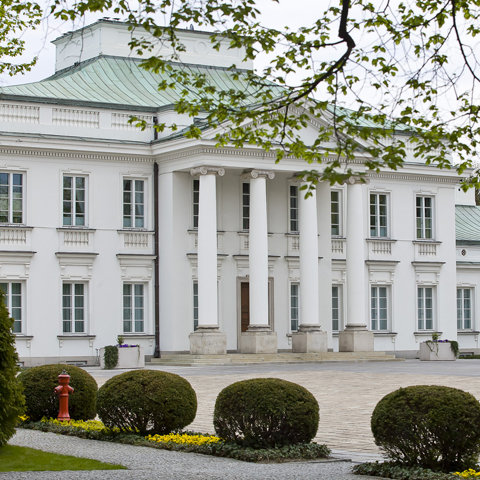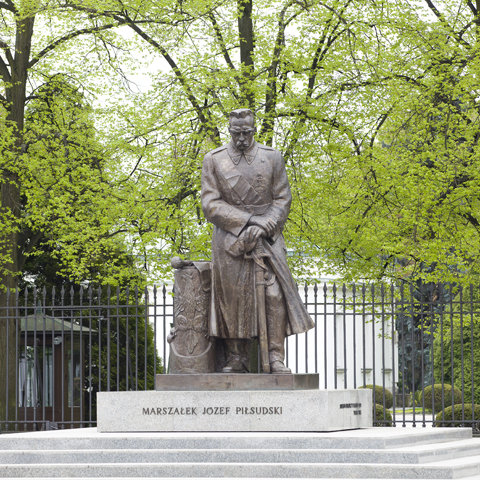Composers / Fryderyk Chopin / Places catalog
Belvedere
The Belvedere dates back to the seventeenth century. The Grand Chancellor of Lithuania, having purchased the land from the Royal Chapel Master, Bartłomiej Pękiel, built his suburban residence there. Shortly after, Chancellor Pac gifted the mansion to his wife, Klara Izabella [Claire-Isabelle] de Mailly Lascaris, a French lady-in-waiting in the retinue of Queen Maria Ludwika [Marie Louise]. The residence bears the name ‘Belvedere’ (It. ‘fine view’) in the deed of endowment.
The Pac manor survived until the 1730s. The cause of its destruction is not known, but it was most likely a fire. At that time, King Augustus II leased all of Ujazdów, including the land on which the Belvedere stood. A new rococo structure was erected on the site of the erstwhile residence of the Chancellor’s wife. The architect was Józef II Fontana, father of the famous Jakub Fontana, court architect to King Stanislaus Augustus. The Belvedere briefly passed to the Princes Lubomirski, before coming into the possession of Stanislaus Augustus in 1767. The king decided to set up a Royal Faience Manufactory in the palace. Porcelain was manufactured there for the first few years due to the unprofitability of faience. The plant was beset with many difficulties, not least of which was water drainage. Eventually, the king reluctantly leased the factory to a certain Franciszek Józef Schütter (who enjoyed the monarch’s favour, so it was rumoured, mostly on account of his comely wife). Schütter, however, failed to save the ailing enterprise, and it closed its doors in 1783.
A whole new chapter in the history of the Belvedere began in 1818, when it was sold to Tsar Alexander I, who designated it the residence of the commander-in-chief of the Kingdom of Poland: his brother, Grand Duke Constantine. The palace was remodelled a year later. The architect Jakub Kubicki soon transformed it from a rococo residence into a neoclassical one. The Belvedere was altered inside and out. ‘The most striking interior was the Blue Hall, named after the colour of the upholstery and curtains’, writes Marek Kwiatkowski. ‘It is now the Pompeian Hall. There is a rounded cavity in the main wall of the room, where a divan was once placed. Grand Duke Constantine used to spend most of his evenings here in the company of his wife, Joanna Grudzińska, Duchess of Łowicz, and his son Paweł. The recreation room, an octagonal chamber adjacent to the Blue Hall, has changed little since the times of the Grand Duke.’
It was in the Blue Hall that the youthful Fryderyk Chopin displayed his pianistic virtuosity before the Grand Duke's family and guests. Eustachy Marylski wrote in his memoirs that ‘the carriage of Grand Duke Constantine would fetch him every Sunday, so that he could spend the entire day playing with young Paweł at the Belvedere.’ ‘As he often visited and played for His late Imperial Highness the Grand Duke Constantine at the Belvedere, he dedicated a march of his own composition to him”, writes Kazimierz Wóycicki. ‘The Grand Duke told him to play it. He liked the work of the young Fryderyk so much that he marched around the room with a smile beating time. When [Fryderyk] played and improvised, he usually raised his eyes and fixed them on the ceiling. The Grand Duke would then ask “What are you looking at up there? Are you reading the notes?”’
The Grand Duke’s son Paweł played with Fryderyk and the young Countess de Moriolles (known as ‘Moriolka’), the daughter of Paweł’s tutor, in the gardens behind the palace. These had been fenced off and redesigned in 1819. Yet these amusements were probably not all that frequent and would have taken place under the watchful eyes of governors. This is because, as Marek Kwiatkowski writes, in the days of the Grand Duke, the Belvedere was a magnet for informers, ‘and imprisoned patriots, frequently without trial, chained to wheelbarrows, worked tending the garden.’
The Belvedere wrote itself into Polish history on 29 November 1830, when the November Uprising was launched with an botched attack on the Grand Duke’s palace. Constantine managed to give the insurgents the slip and escape with his life.
-

Belweder. Phot. Waldemar Kielichowski.
-

Belweder. Phot. Waldemar Kielichowski.
-

Józef Piłsudski Monument. Phot. Waldemar Kielichowski.